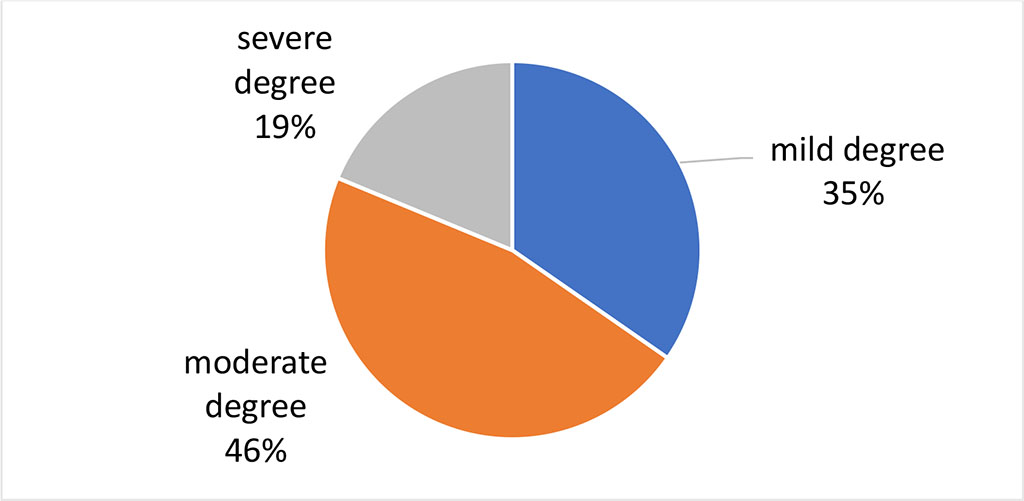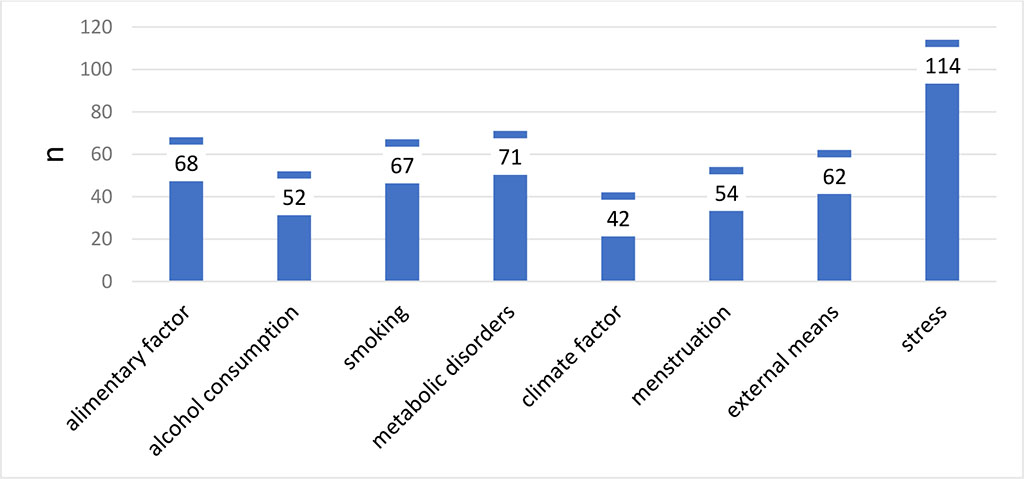- Home
- About the Journal
- Peer Review
- Editorial Board
- For Authors
- Reviewer Recognition
- Archive
- Contact
- Impressum
- EWG e.V.
Cite as: Archiv EuroMedica. 2022. 12; 6: e1. DOI 10.35630/2022/12/6.21
The presence of acne leads to cosmetic defects of the face, which greatly reduces a person's self-esteem. Therefore, it is relevant to assess the risk factors for acne in females (n=176). We analyzed possible risk factors for akne: bad habits, eating behavior, features of physiological processes, the presence of metabolic disorders.
Results: Stress was the cause of acne in almost 2/3 of cases. Approximately in equal amounts, the causes of acne in women were the alimentary factor, metabolic disorders, and smoking. Approximately half of the cases of acne vulgaris contributed to the onset of menstruation and alcohol consumption.
Conclusions: Knowing and identifying the causes of acne is the first step to preventing and treating it.
Keywords: adult female acne, post acne, acne vulgaris, causes, dietary disorders, metabolic disorders.
Acne vulgaris (acne, acne) is a chronic relapsing multifactorial disease of sebaceous hair follicles. Acne affects on average 60 to 80% of people aged 12–24 years [1]. With a favorable course, the process is completed by the age of 18–20 [1]. But in 20% of cases, regression is slow, and acne persists at the age of 25–34 years (8% of cases) and at the age of 35–44 years (3%) [1]. In about 2% of patients, the prolonged presence of acne leads to the formation of atrophic and hypertrophic scars. Therefore, the term "post-acne" exists. Most often, post-acne manifests itself in the form of skin hyperpigmentation, pathological scars, stagnant spots, etc. Clinical manifestations of acne and post-acne lead to cosmetic skin defects, which have a significant impact on the psychological health of the patient.
The factors that cause the appearance of acne vulgaris can be varied: genetic predisposition, hormonal and immune disorders, psychological and iatrogenic factors. It is believed that even an imbalance of carbohydrates, proteins and fats in food can lead to acne [2]. All these factors together contribute to increased production of sebum, which leads to the release of inflammatory mediators in the skin, hyperkeratosis and infection.
Aim: To assess specific female risk factors for acne.
We examined 176 women aged 18 to 50 years. The study included women who had acne vulgaris of varying severity. In all patients, we carefully analyzed possible risk factors for acne: bad habits (tobacco and alcohol abuse), eating behavior, characteristics of the ovarian-menstrual cycle, the presence of chronic diseases and metabolic disorders. We paid special attention to detecting the presence of stress before the appearance or progression of acne. Based on the examination of patients, we determined the severity of acne.
Statistical analysis was performed using spreadsheets “EXCEL” and “STATISTICA 8.0”, parametric and non-parametric methods used in biomedical statistics. Differences were considered significant at p<0.05.
The mean age of women with acne was 32.1 ± 5.3 years. In most cases, acne was of moderate severity (82/46.5%) (Fig. 1). In the remaining women, we observed mild to moderate acne (61/34.6% and 33/18.9%, respectively) (Fig. 1). Most often, acne was represented by papules (66/37.5%), pustules (51/30.4%) and comedones (59/33.5%).

Fig. 1. Distribution of patients according to the severity of acne
The structure of trigger factors that contribute to the appearance of acne is shown in Fig. 2. In most patients (64.7%), acne appeared after stress. Also, the most common causes of acne were lifestyle features: smoking (38%), alcohol abuse (29.5%), diet violations (38.6%), which led to metabolic disorders in 40.3% of women. It is worth mentioning that 154 (87.5%) patients had several causes of acne at the same time.

Fig. 2. Distribution of patients with acne considering trigger factors contributing to the progression of the disease (n=176).
Diet disorders (alimentary factor) in most women were represented by excessive consumption of chocolate (24/35.2%), dairy products (27/39.7%), sweets (38/55.8%), flour products (41/ 60.2%), beef (18/26.4%).
The work of the sebaceous glands is influenced by hormones, the autonomic nervous system, lifestyle, etc.
Nutritional problems can affect the patient's skin condition. If the daily diet contains a small amount of coarse plant fibers and is rich in simple carbohydrates, then favorable conditions are created for the development of acne vulgaris. According to Costa A. et al, chocolate is considered a factor that can exacerbate acne [3]. Dermatologists have noticed that new acne in patients appears within a few days after eating products containing chocolate [3]. Observations by Ismail N.H. et al showed a positive correlation between the occurrence of acne and increased consumption of milk and ice cream (n=44) [2]. A large study by Roengritthidet K. et al showed that the risk factors for increased severity of acne in 2,467 people were: chocolate consumption more than 100 g per week (OR 1.29; 95% CI 1.07–1.56) [4]. At the same time, correction of the diet in patients with acne and the addition of omega-3 fatty acid and gamma-linolenic acid to their food for 10 weeks improve the skin condition [5].
Other authors indicate that acne may appear after stress. Moreover, severe sleep disorders (66.7%) were a common cause of stress in the observation group [6]. An increase in stress severity is significantly correlated with an increase in acne severity (p<0.01) [7].
Our study showed that in almost 2/3 (64.7%) patients with acne, an exacerbation of the process was observed after nervous stress. In second place among the causes of acne were errors in nutrition and non-compliance with the diet.
The causes of acne are varied. As a rule, they are associated with the patient's lifestyle, hormonal disorders, environmental factors. The first step to eliminating acne is leveling the causes of the disease. The main cause of acne in women is stress.